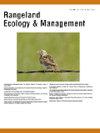测量草地连通性的间隙截距法评价
IF 2.4
3区 环境科学与生态学
Q2 ECOLOGY
引用次数: 0
摘要
描述牧场上物质、生物和能量的连通性对于理解和管理生态系统对干扰的响应至关重要。20多年来,科学家和牧场管理者一直使用间隙拦截法来监测连通性。然而,利用间隙截距测量来推断生态系统过程或为放牧地的管理行动和保护实践提供信息一直受到限制,因为很少有工具和综合方法来帮助管理者实用地解释间隙测量。在本文中,我们回顾了间隙截距法的不同方法,并强调了收集和使用间隙截距数据时的注意事项。我们讨论了如何利用间隙截距数据来评估风蚀和水蚀、生物结壳丰度和组成、土壤肥力、植物群落动态、野生动物栖息地特征、燃料连通性和火灾行为。最后,我们确定了收集和使用间隙截距数据来评估牧场连通性、生态系统功能和生态过程的新机会。通过这一综合,我们展示了间隙截距法的价值,特别是“全植物”(即整个群落)冠层间隙在支持牧场条件和脆弱性评估以及规划未来管理行动方面的价值。本文章由计算机程序翻译,如有差异,请以英文原文为准。
Evaluation of the Gap Intercept Method to Measure Rangeland Connectivity
Characterizing the connectivity of materials, organisms, and energy on rangelands is critical to understanding and managing ecosystem response to disturbances. For over twenty years, scientists and rangeland managers have used the gap intercept method to monitor connectivity. However, using gap intercept measurements to infer ecosystem processes or inform management actions and conservation practices on rangelands has been limited because there are few tools and syntheses to help managers pragmatically interpret gap measurements. In this synthesis, we review the different ways the gap intercept method is conducted and highlight considerations when collecting and using gap intercept data. We discuss what is known about how gap intercept data can be used to assess wind and water erosion, biocrust abundance and composition, soil fertility, plant community dynamics, wildlife habitat characteristics, and fuel connectivity and fire behavior. Finally, we identify emerging opportunities regarding the collection and use of gap intercept data to assess rangeland connectivity, ecosystem function, and ecological processes. Through this synthesis we demonstrate the value of the gap intercept method, particularly “all-plant” (i.e., whole-community) canopy gap, in supporting assessments of rangeland condition and vulnerability, and in planning future management actions.
求助全文
通过发布文献求助,成功后即可免费获取论文全文。
去求助
来源期刊

Rangeland Ecology & Management
农林科学-环境科学
CiteScore
4.60
自引率
13.00%
发文量
87
审稿时长
12-24 weeks
期刊介绍:
Rangeland Ecology & Management publishes all topics-including ecology, management, socioeconomic and policy-pertaining to global rangelands. The journal''s mission is to inform academics, ecosystem managers and policy makers of science-based information to promote sound rangeland stewardship. Author submissions are published in five manuscript categories: original research papers, high-profile forum topics, concept syntheses, as well as research and technical notes.
Rangelands represent approximately 50% of the Earth''s land area and provision multiple ecosystem services for large human populations. This expansive and diverse land area functions as coupled human-ecological systems. Knowledge of both social and biophysical system components and their interactions represent the foundation for informed rangeland stewardship. Rangeland Ecology & Management uniquely integrates information from multiple system components to address current and pending challenges confronting global rangelands.
 求助内容:
求助内容: 应助结果提醒方式:
应助结果提醒方式:


